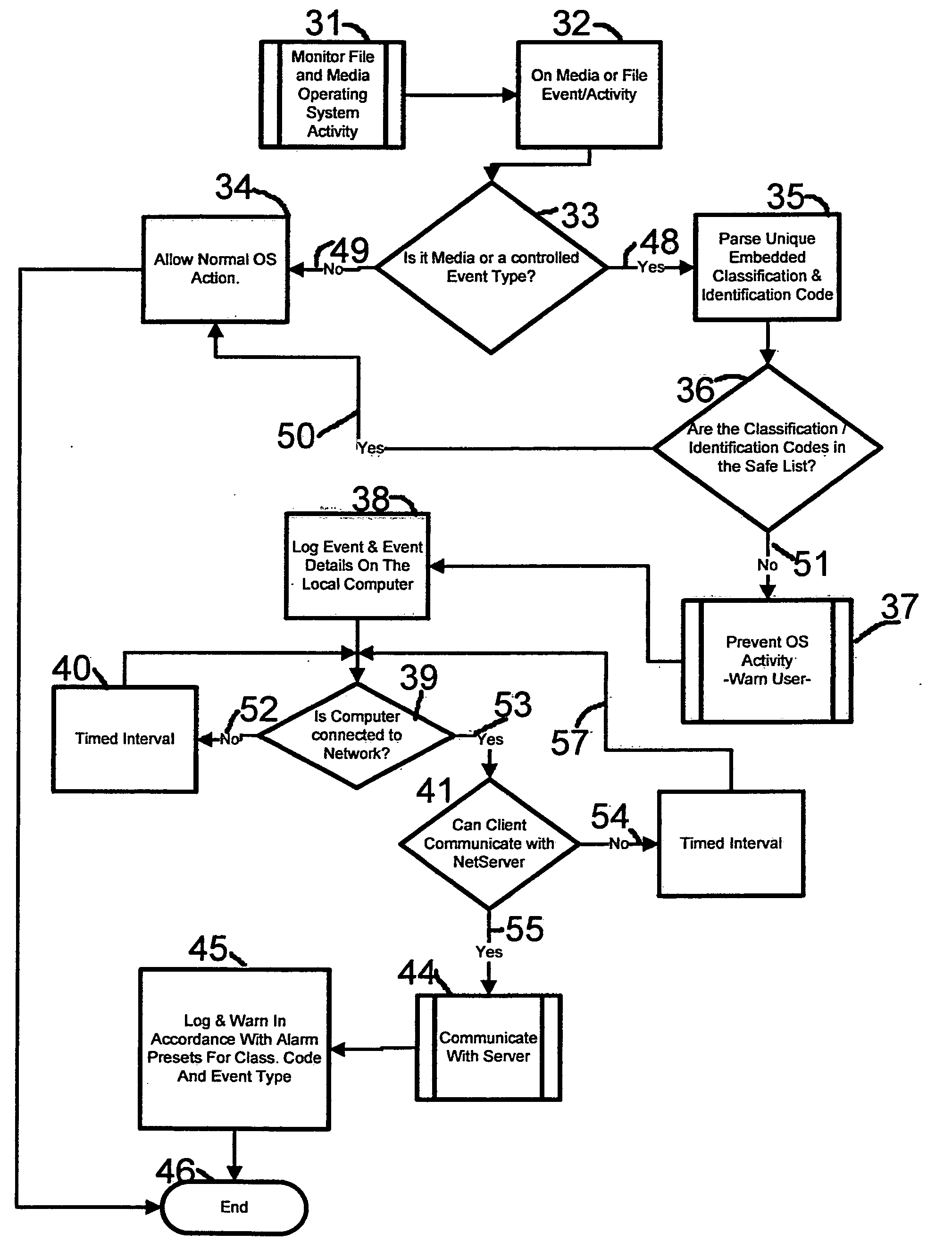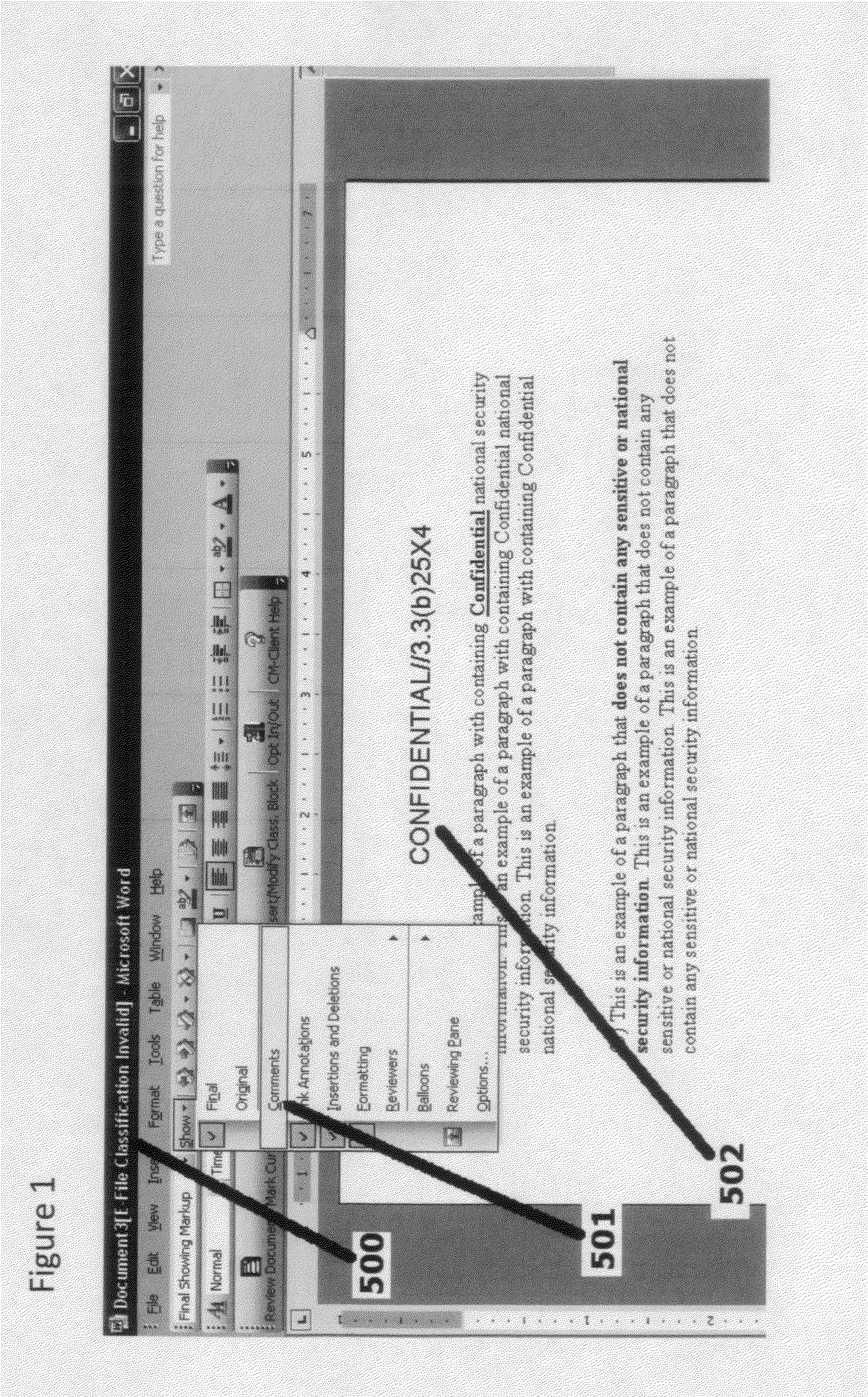The productivity attributes of document development
software applications have compounded this document /
information security problem by providing
hard copy output generation or other electronic output views of the information contained in electronic documents, that may not reflect the full content of the information contained in an electronic document, and thus may not reflect the full sensitivity or national security classification of the information contained in the electronic document, thereby subjecting the document / information to possible mishandling and / or compromise.
The productivity gains of computers, computer networks, and document development
software, have led to the development of sensitive and classified computer networks without sufficient methods for positive identification and persistent and consistent feedback for the developer / user of an electronic document of all possible information in the electronic document as well as the lack of developer / user capability to assign or determine corresponding sensitivity or classification designation for the informational content of the entire electronic document.
In addition, current security processes and
software to control information in electronic documents do not provide adequate assurance and
verification and alerting capabilities to determine that the information is not breaching
physical security perimeters among networks or domains of networks, approved for different levels of sensitive or
classified information.
Recent inventions that provide user assurance of appropriate national security or sensitivity classification assessment and classification determinations for information in electronic documents, persistent document marking capability for electronic documents, and the association of unique classification codes embedded in the document's electronic shell, have not fully accounted for the information classification problem associated with productivity features found in most document development host software applications.
The ability to provide comments or notes within a document or to hide text / information in an electronic document or it's electronic shell, as well as the ability to provide application or
user driven subset views of the information contained in an electronic document are some typical document development software application features that may mislead a user's understanding or ability to ascertain the full or complete classification or sensitivity value of the information contained within the total electronic document and may cause the mishandling or compromise of information contained in an electronic document.
Currently, user's of electronic document files are unable to determine a classification or sensitivity distinction between a subset view of the informational content of a document generated by a document development software application that they may be handling and the full or complete classification determination of the all the information regardless of the application attributes, visible, hidden, etc, assigned to information contained in the document.
Control systems based on document / information sensitivity and classification determinations that do not account for the full or complete sensitivity or classification potential of the information contained in an electronic document have ineffective control structures and establish potential systemic or “programmed-in” vulnerabilities into the control systems for electronic documents.
The current state of developing,
processing and disseminating sensitive and / or classified
electronic information for stand-alone computers, networked computers and domains of networks is piecemeal, relying on disparate, text based sensitivity determinations on possible subset informational or “print” views of the electronic document to identify sensitivity or national security classification, and provide ineffective security control of the movement of, and access to, sensitive and / or classified electronic documents / information on computer networks.
Such control systems have not accounted for the potential to overlook portions of the content of an electronic document that may change the value of the document's sensitivity or classification.
Failure to view or account for such potentially hidden information when classifying a document as to it's sensitivity or national security designation may lead to catastrophic miss-classification of the document / information and have a
ripple effect for subsequent users of the document that rely on the text classification marks of the “print” view of the document to determine how to appropriately disseminate, move or store an electronic document on a
computer network.
The productivity gains of computers and computer networks as well as associated communication capability to transmit electronic document information exacerbate this
information control problem.
In addition, subsequent users of such documents may be mislead by subset views provided by modern document development software applications of the information contained in an electronic document which may result in false assumptions of the classification value of the displayed or subset information, resulting in mishandling of the electronic documents as well as mishandling printed views of the subset information.
In addition to an improperly marked
hard copy of the information, the second user unknowingly forwards the electronic document to another user on the network who is not authorized to have access to the information contained in the comments, thereby compromising the information.
Document development and
dissemination software has also led to multiple computers, possibly representing multiple networks, side by side on users desks at different levels of sensitivity or classification without sufficient capability to alert security personnel to breaches or spills of information, whether intentional or inadvertent, among the various systems.
Compounding these systemic flaws, there currently is little positive and accurate control and tracking over the access to and the movement of such information within the security perimeters of authorized computer networks or among authorized network domains.
As a result, Government and businesses are grappling with intentional insider threats and perimeter breaches to sensitive and
classified information on their systems, as well as inadvertent disclosures from their systems that compromise protected critical or national security
classified information.
Attempts at text-based controls for sensitive and classified information have been ineffective due to false negatives as well as false positives, and their inability to adequately
handle compilation classification designations as well as the inability to
handle graphics and other modern features of computer document development software.
 Login to View More
Login to View More  Login to View More
Login to View More 


